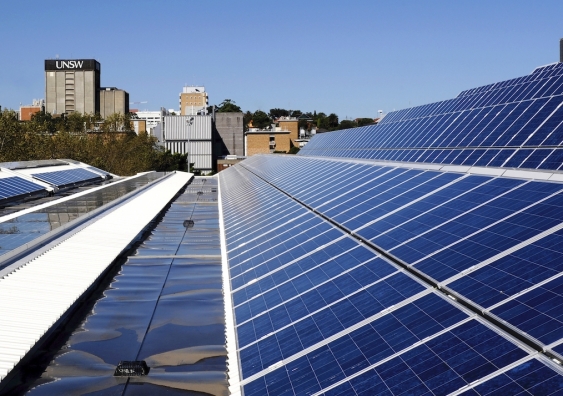UNSW awarded more than $7m for renewable energy research and development
World-leading solar research will address cost-effectiveness and sustainable end-of-life management.
World-leading solar research will address cost-effectiveness and sustainable end-of-life management.

Estelle Jones
Kirby Institute Communications Officer
+61 (02) 9385 9987
e.jones@kirby.unsw.edu.au
UNSW Sydney researchers have been awarded a share of $15.14 million from the Australian Renewable Energy Agency (ARENA) Research and Development (R&D) Program to help address solar photovoltaic (PV)Ā panel efficiency, overall cost reductions and end-of-life issues.
The researchers from UNSW Engineering will receive more than $7 million for six projects in the areas of advanced silicon, tandem silicon and end of life. This is the first time ARENA has sought applications addressing solutions to end-of-life solar PV issues.
āA key part of the funding round was finding a solution to the end-of-life of solar panels and weāre excited to see some interesting new research into this,ā said ARENA CEO Darren Miller. āItās an important part in our transition to renewable energy as we need to ensure that materials used in solar panels can be recycled or remanufactured in solar panels or in other high value applications.ā
UNSW Deputy Vice-Chancellor, Research, Professor Nicholas Fisk congratulated the UNSW researchers on their strong result, securing more ARENA R&D grants than any other university in Australia.
āOur talented researchers continue to lead in this area,ā Professor Fisk said. āAs global demand for renewable energy ramps up, the efforts of UNSW engineers will have a major impact on the nationās R&D capability over the whole lifecycle of solar PV.ā
Scientia Professor Martin Green, School of Photovoltaic and Renewable Energy Engineering, is lead Chief Investigator (CI) on the āReduced solar module temperatureā project which has received a $1,767,730 R&D grant from ARENA. The project aims to develop cost-effective approaches to reducing photovoltaic module temperature rise when modules operate in the field. This will help in achieving the broader aim of having improved technology taken up by module manufacturers as rapidly and as widely as possible to quickly further reduce the cost of photovoltaic energy and accelerate its uptake.
The projectās other UNSW CIs are: Professor Renate Egan, Associate Professor Nicholas (Ned) Ekins-Daukes, Dr Jose Bilbao, Dr Mark Keevers, Dr Yajie (Jessica) Jiang, Dr Zibo Zhou, Dr Victoria Timchenko, Dr Charitha de Silva, Dr Svetlana Tkachenko, Dr Supriya Pillai, Associate Professor Dewei Chu and Dr Nathan Chang.
Professor CheeMun Chong, School of Photovoltaic and Renewable Energy Engineering, is lead CI on the āEnd-of-life closed loop recycling and remanufacturing end-of-life silicon photovoltaic modules: towards a circular economyā project which has received a $1,560,000 R&D grant from ARENA. The project will develop the first economically viable technologies to recycle solar modules and reuse recycled materials to remanufacture ānewā PV modules.
The projectās other UNSW CIs are: Associate Professor Jingjia Ji, Dr Jose Bilbao, Dr Richard Corkish and Dr Nathan Chang.
ARC Future Fellow Associate Professor Yansong Shen, School of Chemical Engineering, is the lead CI on the āA highly efficient, low-cost and eco-friendly recycling technology for silicon photovoltaicsā project which has received a $1,360,000 R&D grant from ARENA. In this project, inspired by metallurgy engineering, the team aims to develop a demonstrable and highly efficient low-cost and sustainable recycling technology for End-of-Life photovoltaic solar panels with respect to the entire supply chain.
The projectās other UNSW CIs are: Associate Professor Ziv Hameiri, Scientia Professor Rose Amal and Professor Gregory Leslie.
Scientia Fellow Associate Professor Brett Hallam, School of Photovoltaic and Renewable Energy Engineering, is lead CI on the āAdvanced Silicon, next-generation selective emitters for commercial PERC and TOPCon solar panelsā project which has received a $1,232,429 R&D grant from ARENA. The projectās overarching aim is to develop low-contact area screen-printed metallisation scheme to address the performance-limiting factor for industrial PERC and TOPCon solar cells ā namely emitter and metal/Si interface recombination on the front surface.
Associate Professor Ziv Hameiri, School of Photovoltaic and Renewable Energy Engineering, is the lead CI on the āLower PV cost by a combination of luminesces images and machine-learningā project which has received a $694,224 R&D grant from ARENA. The project aims to remove major roadblocks towards achieving cost-effective silicon solar cells with higher efficiency and stability.
The projectās other UNSW CIs are: Professor Thorsten Trupke and Professor Sowmya Arcot.
ARC Future Fellow and Scientia Associate Professor Xiaojing Hao, School of Photovoltaic and Renewable Energy Engineering, is the lead CI on the āAbundant RoHS-compliant antimony chalcogenide: top cell alternative for Si tandem cellsā project which has received a $693,388 R&D grant from ARENA. The project will implement a bottom-up research and development approach starting from 10 per cent benchmark efficiency antimony chalcogenide solar cell established by the project team to maximise the full potential of antimony chalcogenide, providing an appealing alternative top cell with excellent merits for Si-based tandem. This project will bring new findings, key technological step-change milestones, record efficiency antimony chalcogenide cells and, more importantly, provide a viable top cell alternative, maximising chances of success for next-gen Si-based tandem PV technologies where there are no well-agreed ideal top-cell solutions.
The projectās other UNSW CIs are: Dr Kaiwen Sun, Dr Jianjun Li, Scientia Professor Martin Green, Associate Professor Nicholas (Ned) Ekins-Daukes, Professor Yansong Shen and Professor Bram Hoex.